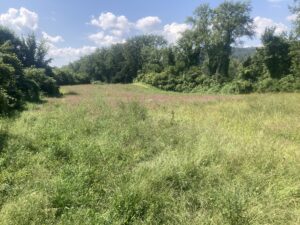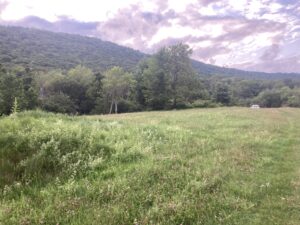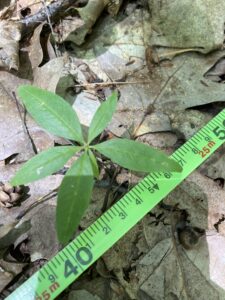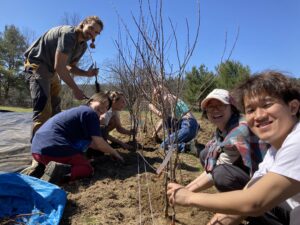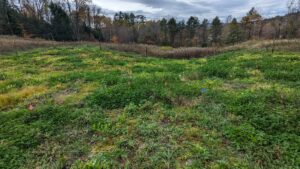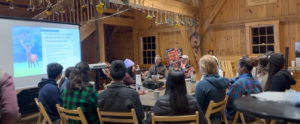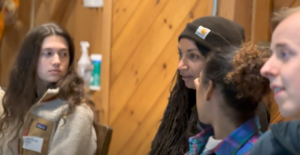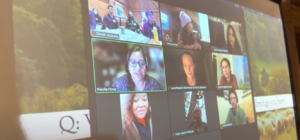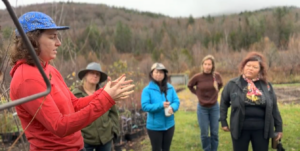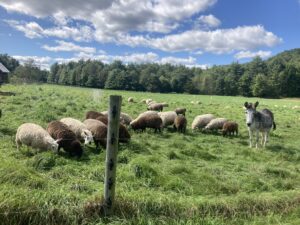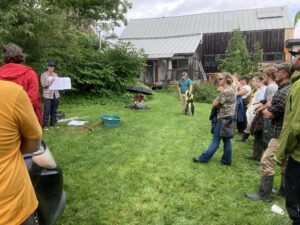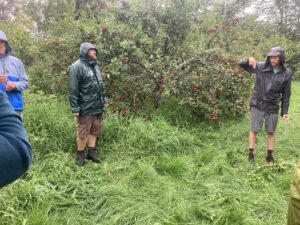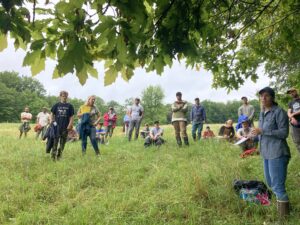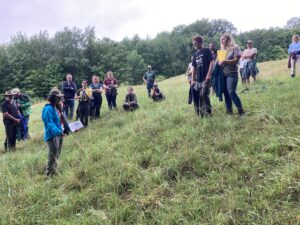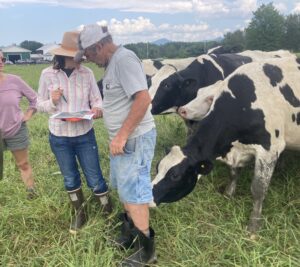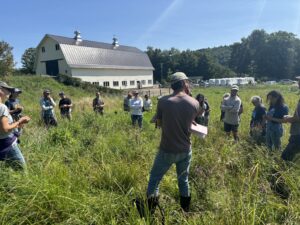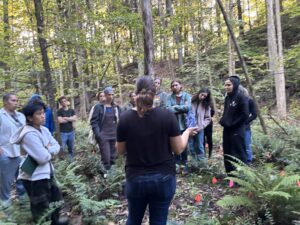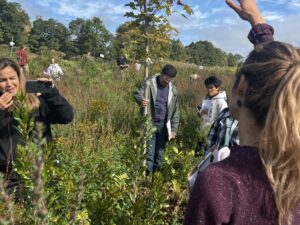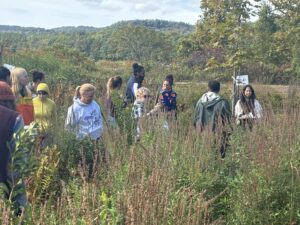Progress report for LNE22-441
Project Information
Problem or Opportunity and Justification
An emergent body of research suggests that agroforestry practices provide a wide range of benefits to remediate ramifications of the intensifying sustainability and climate crisis including the loss of soil carbon and fertility, threats to water supply, biodiversity losses, and the viability of small farms under changing climatic and environmental conditions. However, even as recent national and regional afforestation proposals to mitigate climate change have gained traction, meaningful promotion, uptake, and transitions to agroforestry systems have been slow in the United States. From the perspective of commercial farmers in the Northeast, particularly diversified operations with tight economic margins, investments in long-lived and expensive trees must be demonstrated to reliably benefit their operations to be worth up front costs. To attract and ease transitions for early adopters, technical and educational support are also requisite and must be transmitted both horizontally (farmer to farmer) and vertically (across institutions).
Solution and Approach
Here we propose to use both horizontal and vertical methods to grow the current understandings of and best practices for agroforestry, how these systems enhance ecological function, and to train farmers how to establish and maintain agroforestry systems that support their management objectives. To achieve this goal and bolster a durable network of agroforestry practitioners, we have a 3 year plan to establish an Agroforestry Transition Hub that will serve as a local nursery provisioning tree seedlings, a school offering training and networking for 25 farmers interested in newly adopting or expanding agroforestry, an online platform to track and publicize farmer progress and monitoring, and a body of research that will use an interdisciplinary mixed method approach to enhance the relevance, agroecological benefits, and success of agroforestry systems.
We will use social science methodologies to explore current perspectives on tree planting and long-term care across the dominant types of agriculture in the Northeast, stratifying by operational size and farm sector. This work will expand options for agroforestry for practitioners and ensure that future implementation for our projects and others will successfully incorporate farmer attitudes. Additionally, we will use aerial photography and vegetative surveys to determine the spatial extent, composition, and health of tree resources and model their contribution to landscape resilience. Our work will investigate the role of trees on farms, and point to ways that farmers, foresters, and other stakeholders can work together to bolster forest health and agricultural productivity.
In year one, we will focus on farms within the Upper Valley of Vermont (VT ) and New Hampshire (NH), in years two and three, we will expand our programming to include a broader geographic span in VT and NH and make programming available for auditors across the northeast region. Update (2025): We initially had planned to begin in NH and VT and then expand into the greater Northeast region. However, we recognized that the demand was so high locally and widely distributed across the two states---already representing a wide geographic scope. Thus, for the first two years we focused on this study region and then for year three, we expanded our scope and changed our programming to accommodate farmers from Maine, New York and Massachusetts in addition to Vermont and New Hampshire.
As a direct result of our work, agroforestry will be adopted by 25 farmers on a minimum of 25 acres resulting in the development of an agroforestry hub in the Upper Valley of Vermont and New Hampshire, a four county region. The hub will act as a source of resources for catalyzing further agroforestry uptake. Farmers will receive seedlings and support to bolster on-farm climate resilience measured programmatically by soil health indicators. Our target is 200 farmers reached through peer-peer networking and measurable improvements in soil water infiltration for 75% of the 25 farms participating in the training program.
Agroforestry is an intensive land management system that optimizes the benefits of deliberately combining trees and/or shrubs with crops and/or livestock including alley cropping, silvopasture, forest farming, windbreaks, and riparian forest buffers (Bentrup et al. 2018). Agroforestry practices are derived from a suite of indigenous land management strategies regionally and globally, some of which have attracted attention as interest in the integration of woody crops has risen, and provide an important grounding point to exploring the role and potential of woody components to increase, sustain and diversify the production in farming systems.
These practices are cited for their potential to combat climate change directly through the sequestration of greenhouse gasses and contribute a host of other potential benefits including physical barriers to protect farms from wind and flooding, creation of preferable microclimates, conservation of soil and water, provision of shade to livestock, diversification of diets, the maintenance of soil health, and landscape complexity. Consequently, across many regions, agroforestry can be an unique solution to address multiple challenges on agricultural landscapes facing ramifications due to global climate change. This is particularly true in the Northeastern United States, where the climate supports temperate forests and the region has experienced increases in extreme precipitation and increased temperature (NCA 2014). Thus, a range of agricultural industries are faced with the new challenges of climate change on production including reduced soil stability, decreased crop productivity, heat stress on livestock, drought, and increased pest and weed pressure (Howden et al., 2007; McCarl, 2010; Claggett, 2017). Northeastern farmers are faced with adapting quickly to changes--- a survey of 193 farmers found that 72% made changes on their farm in response to extreme weather (White, 2019).
However, despite cited benefits and recent national and regional proposals promoting tree planting and growing interest in farmers for climate change adaptation, agroforestry transitions are complicated. From the perspective of commercial farmers in the Northeast, particularly diversified operations with tight economic margins, investments in long-lived and expensive trees must be demonstrated to reliably benefit their operations to be worth up front costs. Lack of diverse information about how to implement and integrate agroforestry systems into their existing enterprises may be one of the most significant barriers for landowners (Coggeshall, 2011; Fin et al., 2008; Gold et al, 2004; Jacobson and Kar, 2013; MacFarland, 2018). The lacking supply of trees, particularly those valued for agroforestry, poses additional concerns particularly as demand from other reforestation/afforestation campaigns fractionate supply from an already imperiled reforestation pipeline (Fargione et al. 2021). Social theory suggests that both horizontal (farmer-to-farmer) and vertical (across institutions) transmission of knowledge and resources are necessary for spurring effective food systems change (Rosset and Martinez-Torres, 2012; Rosset and Altieri, 2017; Carlisle et al., 2019).
For this project, we are keenly interested in understanding the nature and rate of, and justifications for agroforestry transitions. We use both horizontal and vertical methods to grow the current understandings and practices of agroforestry and co-develop small scale agroforestry projects with farmers that support their management objectives. To achieve this goal and bolster a durable network of agroforestry practitioners, we are establishing an Upper Valley Agroforestry Transition Hub that will serve as a local nursery provisioning tree seedlings, a school offering training and networking for 25 farmers interested in newly adopting or expanding agroforestry, and an online platform to track and publicize farmer progress and monitoring. We are prioritizing BIPoC farmers as the primary recipients of our educational programming.
Through activities associated with this grant, we are assembling an interdisciplinary body of research to understand the breadth and depth of transitions in agroforestry in the northeast. We will tracking engagement with participants in our educational programming to investigate why farmers are interested in adopting agroforestry practices, what factors prove to be the most influential in their transitions, and if they are prompted to expand the scope of their agroforestry transitions. Outside of our direct educational programming, we are working with thirty farms across sectors in the upper valley region of Vermont and New Hampshire to understand current engagement, interest, and perspectives in agroforestry. With these farms, we also are conducting vegetation surveys to understand how management decisions and global change factors interact to impact agroforestry systems and forest holdings on farms to better understand how ecological agroforestry transitions manifest now and shed light on how they will occur in this era of global change.
Cooperators
- (Educator)
- (Educator)
- (Educator)
Research
- Project 1: Exploring the tree planting and protecting culture of farmers in the Northeast: Opportunities for Agroforestry:
- What types of trees are farmers actively protecting, planting, and preserving on their landscapes? Why?
- Do farmers want to plant more trees? How does this vary by sector?
- Project 2: Investigating the prevalence of wooded areas and integrated trees on the agroecological matrix of New England farms:
- What is the extent, structure, composition, and patterns of trees and herbaceous vegetation farms integrated into crop production, in marginal areas, and in woody patches?
- How does this vary by agricultural sector, production style, land-use history, and demographic profile?
The promotion of agroforestry has generally been characterized by approaches that promote a few priority tree species, within a restricted suite of technological packages that do not integrate current farmer perceptions of trees, or consider larger scale agroecological processes. New methods are needed to generate diverse sets of agroforestry options that can reconcile production and conservation objectives and embrace varying local conditions across large scaling domains.
Through this initiative, we will establish two separate research projects that will address these concerns by investigating the current extent and perceptions of trees on agricultural landscapes and explore and inform scalable ways for farmers to establish more trees suited for agroforestry systems. These projects will comprehensively create a robust profile of northeastern farmer tree resources and provide important information on how farmers can appropriately scale up tree planting successfully to enhance resiliency at the landscape level.
Project 1: The tree planting and protecting culture of farmers in the Northeast: Opportunities for agroforestry
We will document the tree species that the farmers utilize, plant, and protect on their land or would like to plant, and the motivations for these practices. We will highlight tree species with multiple uses and consider the role that trees play in the land use strategies and livelihoods of the farmers. This research will help inform our project by providing recommendations for scaling up tree planting through agroforestry initiatives that build upon the farmers’ existing and diverse tree planting and protecting practices and interests.
- Population: We will interview at least thirty farmers in the Northeast. We will stratify our interviewed farmers by sector, size, and production style. We will focus on prominent industries of agricultural production in the Northeast---dairy, vegetable production, fruit tree production, and livestock. We will use farm census data to establish thresholds for farm size and for each sector and sample equitably per size class.
- Methodology: We will perform semi-structured interviews with farmers on their farm landscapes to have a rich, interactive interview that captures attitudes on all woody vegetation across farm landscapes. We will also create a master list of all local names of tree species that farmers mention or show us throughout the questionnaire that includes the uses and values respondents assigned to each species.
- Data Collection and Analysis: We will use laptops and phones to collect audio responses of farmer responses to questionnaires. Each question will be read aloud to respondents and their unprompted answers will be recorded verbatim. Then, we will code our data anonymously in our sheet. We will sort responses into categories, identifying themes across sectors and within sectors, and analyze them using frequency tables. We will use statistical analyses to review our results including ANOVA.
- Farmer Input: In our work, we have found that frequently, farmers have difficulty recalling areas with trees on their landscape whether they are on marginal farmland, large wolf trees, or riparian barriers when prompted via the phone. Many farmers have stated that field walks would be instrumental to apprise them of the tree resources of their farm and a way to bolster management for social, economic, and ecological reasons. To capture perspectives on the myriad ways farmers are engaging with trees on their property, we will engage with them on their landscapes to gain a complete understanding of farmer perceptions. This research seeks to predominately valorize current farmer perspectives and knowledge sets around trees as a principal component in the development of agroforestry systems across the Northeast.
Project 2: Investigating the prevalence of wooded areas and integrated trees on the agroecological matrix of New England farms
Changes in forest species diversity and composition, structural diversity (Willis and Whittaker 2002), and the abundance of nonnative species are common national concerns for forests within the US. Farm landscapes in the Northeast usually contain a myriad of different plant communities which fall under the Forest Service’s definition of forest patch (one acre, 120 feet wide), however, these patches are seldom studied or valued for their contribution to landscape health and resilience. Developing agroecosystems that promote resilience necessitates considering agricultural landscape as a heterogenous mosaic of various habitat patches and recognizing areas retaining some balance of original ecosystem structure as important to agricultural productivity (Francis et al. 2003). In this project, we will use aerial photography and vegetation surveys to examine the extent, composition, health, and spatial distribution of trees on farms to model how these patches of trees contribute to climate resilience.
- Treatments: We will take aerial imagery of the thirty farms that we engage with in project one. As such, we will stratify our interviewed farmers by sector, size, and production style, focusing on dairy, vegetable production, fruit tree production, and livestock based on publicly available farm census data.
- Methods: Aerial imagery: We will fly drones usually at an altitude of 150 meters above the ground over the extent of farmers’ farm and forest land and capture their images using a multiSPEC 4C camera. This flight height and camera result in an image resolution on the ground of approximately 30 cm per pixel. Understory vegetation: In any forested patch that meets the minimum area required to be classified as a forest patch (1 acre, 120 feet wide), we will establish two linear transects (10 m length each) 5 m apart one from each other.
- Data Collection and Analysis: Aerial imagery for landscape analysis: We will download our data to one meter per pixel for forest and farm lands with non-visible data of crops over four distinct spectral bands: green, red, red-edge and near-infrared. With this data, we can calculate patch size and farm-use classification (wooded, riparian, pasture, crop field, agroforestry system, etc.). We can then perform landscape pattern and multivariate trajectory analysis to provide a means to quantify the degree of resilience of a system to climatic perturbations using dynamic equilibrium theory (Cushman and McGarigal, 2019). Vegetation composition: With the high resolution from drone imagery, we can also capture the composition of the tree canopy and quantify the dominant and co-dominant age classes of the forest. In addition to aerial data, we will use the point-intercept method (Brancaleoni et al. 2003) to record shrub, herbaceous plants, and seedlings along our transects. We will describe and analyze plant communities using species richness, and community analyses such as Simpson’s index. We will compare richness across wooded areas, across sites, and across agricultural sectors using statistical analyses including ANOVA and ANOSIM.
- Farmer Input: Farmers consistently have mentioned that they don’t understand the economic, ecological, or social benefits of keeping or investing in productive forest patches when they could expand field production. This work will strengthen the scientific and agricultural communities’ understanding of the current spatial extent and health of trees on the agricultural landscape to provide targeted interventions to help farmers better manage these systems for adapting to climate change.
We also will work with farmers to analyze data from their farm to answer their specific questions. We are excited about the critical feedback and questions that farmers will ask and anticipate analyzing data on site to explore farmer questions, and these questions scaling up into formal academic articles with farmer co-authors.
Update 2023: To best quantify patterns of vegetation in woodlots on farms, in conjunction with aerial photography, we have changed our methodology to do transects in from productive to woodlots. Within three meters of a transect laid out, at 10m intervals from 0-60, we identify and record species, dbh, and location on the transect. At the 5m mark of every interval (i.e 5m, 15, 25m...) we lay out a 0.5m x 0.5m quadrat to collect understory data, including both herbaceous plants and seedlings. Additionally, we take soil samples down to 25cm where each quadrat is laid out. More robust sampling here will allow us to better understand the patterns of vegetation within different wooded areas adjacent to and interacting with productive agriculture and understand paired above-ground and below-ground transitions involving trees on farms.
Outreach flyer: We used this outreach flyer to reach out to a wide variety of farmers through email, by phone, and at local events. In doing so, we were able to attract a breadth of farmers. We plan on doing more outreach this winter in order to speak with farmers at the most convenient times.
Example Farm: The link shows examples of data farmers were given from their farm.
Example farm: This link shows an example of the data sheets farmers were sent.
Update 2024: 30 farms in the region varying by state, operational approach, sector, and age were successfully sampled by Fall 2023. We are working to transcribe this set of data since it was primarily taken audibly. We sent back data to farmers and we are working on integrating more metadata to pull together our findings.
Update 2023: To date, we have worked with 15 farms within 30 miles of Dartmouth (Upper Valley region). In 2022, we interviewed and sampled five operations producing exclusively vegetable, five operations working exclusively with livestock (dairy, meat, fiber), and five diversified operations (have a mix of vegetable, fruit, and/or livestock). All farms have received data from vegetation sampling, and had the option to receive aerial photographs as compensation for time. In the summer 2023, we will follow our same protocol for another 15 farms, to have data regarding the culture of tree protection/ preservation in the upper valley and vegetation and soil data for 10 vegetable, 10 livestock, 10 diversified farms in the region to comprehensively analyze perspectives and patterns of agroforestry transitions.
Although relevant to begin analyzing vegetation data after half of the dataset was collected, we found that for Project 1: Exploring the tree planting and protecting culture of farmers in the Northeast: Opportunities for Agroforestry, it would be more relevant to begin analyzing data after dataset is completed in 2023.
Figures for grant report: At this link there are preliminary figures, trends, and captions for the first season of data. We found there to be significant differences between both patch type and production type for tree and understory data. We will be examining these results further and collecting another round of data in the upcoming year.
Update 2025: As mentioned above, we are working on transcribing and cleaning up the whole data set. The project is well on track to be completed by the end of the grant.
Education
Engagement: To recruit farmers into the programming offered through our project, we will rely on the network of our stakeholders to aid in outreach. Further, we will advertise the project through outreach on relevant listservs, local newspapers, and our own social media channels.
We will recruit five cohorts of farmers throughout the project’s duration (1 cohort in year one, 2 cohorts each in years two and three) with five farmers per cohort (spring and fall). Throughout the duration of the farmer training program, farmers will workshop shared goals, roadblocks, and solutions for advancing their pilot agroforestry projects with industry experts as well as one another. Participants will develop portfolios that expand with each course and track plans for implementation, tangible short and intermediate benefits, and relevant trade offs. They will receive written feedback from the project team each week.
To stay connected with farmers and elevate the importance of continued education and networking to the success of agroforestry initiatives in the Northeast, after participants complete the farmer training program, they will act as agroforestry lighthouse operations. We will guide farmers in publicizing and recruiting other farmers to their workshops, and encourage them to lead programming. We expect at least 10 participants per farm workshop, resulting in an additional 250 potential agroforestry practitioners.
We will collaborate with the DALI Lab, a partnership between Dartmouth undergraduates designing web applications and faculty seeking support to make research accessible, to design an engaging website to reach practitioners and others interested in enhancing agroforestry within their communities. We will show farmer portfolios, track progress on project objectives, map a network of members engaged in the program, and share events.
Learning: Based on farmer correspondence, extensive literature review, and assessing similar global programs, we have identified ten sequential two to three hour workshops. Prior to starting the program, participants will choose a site on their farm and/or one of the five USDA agroforestry practices to workshop throughout the course. Workshops will be taught by key individuals, advisory committee members, and guest speakers.
Week 1: Agroforestry introduction: Five practices of agroforestry
Week 2: Benefits of agroforestry to ecological matrix and climate resilience
Week 3: Site visits will occur during weeks 1-3, farmers will use this week as a planning week.
Week 4: Species selection for site and practice
Week 5: Propagation of desired agroforestry trees
Week 6: Successful establishment of tree species
Week 7: Long-term maintenance and care
Week 8: Troubleshooting and monitoring
Week 9: Capitalizing upon regional markets and long-term funding mechanisms
Week 10: Acting as a pilot farm
During the first three weeks of the project, we will conduct individual site visits to participants’ farms. We will discuss their goals and the spatial and temporal elements necessary to consider in implementation that farmers will continue to workshop in subsequent weeks. During visits, we will use a drone to capture aerial imagery of farmers’ landscapes. We will identify areas prone to drought, flooding, nutrient runoff, distance to nearest edge habitat, etc. to inform agroforestry planning.
We will meet in field demonstration sites, at the Dartmouth Organic Farm or other suitable locations in the Upper Valley/Northeast to ground lessons and maximize educational opportunity. Although we will encourage in person attendance to facilitate networking and engagement, we will employ student undergraduate assistants to help film courses for remote-access. When suitable to outplant, farmers will receive seedlings to begin their project.
Additionally, as part of each operation’s implementation plan, researchers at Dartmouth will work with farmers to develop a monitoring plan that tracks the desired benefits of their agroforestry system. Possible examples include: soil aggregate stability and water infiltration in a riparian buffer, net present value of forest farming system, etc. Farmers will provide updates after each growing season for us to track and publicize via their profile on our website.
Evaluation: Over the course of three years, we will monitor our own program to ensure that we are meeting goals and expanding our reach. Metrics will be discussed in monthly and annual meetings by program partners.
Programmatic Success will be tracked by:
- Number of partners engaged (tracked annually by Ong Lab)
Year 1: Partners engaged through one on one meetings and group meetings: 76 (see spreadsheet: Connections)
Year 2: Partners engaged through one on one and group meetings: 94, see tab: Connections
- Number of trees donated to farmers (tracked annually by Ong Lab)
Year 1: Expectedly, 0. However we have orders in for 100+ trees and ~1000 trees growing.
Year 2: We have donated 305 high value trees to farmers thus far, see tab: Inventory and Orders 2022-23. We are working with our second order now to put in orders for our current inventory for Spring 2024 planting.
Year 3: At this point, we have donated 2134 high values trees to farmers! We have a number of trees left that we are distributing to farmers in this coming Spring, or will be donated to the White River Natrual Resource Conservation District to head off to more farms.
- Number of trees planted (reported annually by farmers)
Year 1: Expectedly, 0.
Year 2: 305 trees. We have assisted four different farms from our first cohort with planting projects (constituting 285 trees).
- Number of acres planted with trees (reported annually by farmers)
Year 3: 2134 trees. We have assisted with planting at 20/25 farms that we work with, with many of the farmers from the first cohort, we have helped with several plantings. Orders Donated 2025
Year 1: Expectedly, 0.
Year 2:
Year 3: Farmers planted trees across 35 acres collectively.
- Success of trees (reported annually by farmers)
Year 1: N/A
Year 2: We are still collecting data with our first cohort to assess first year growth.
Year 3: We can report a 93% success rate of plantings and will re-evaluate this summer for final numbers.
- Pre and Post training evaluations (see Milestones for information)
Update 2023:
We have conducted our first cohort between October 20, 2022 and December 2, 2022. We condensed the class into eight sessions as opposed to ten and allowing for hybrid participation for non-field site visits for ease of farmers and make sure that skill based courses could take place in the field despite weather restrictions (see "flyer" for information on site, date, and speakers for our sessions). In our programming, we balanced vertical and horizontal knowledge sharing by bringing in a suite of speakers locally active with agroforestry (11 in total) with conversations before and after classes between participants with additional resources available for farmers to share their thought process. This culminated in site visits, which generally occurred during the last two weeks of the course at the property of the various farmers we were working with, so farmers could share their ideas, questions, and lessons learned from the class with us. This effectively allowed for farmers to engage in knowledge-sharing, evoking a skillset that will serve the greater agricultural community as farmers act as agroforestry lighthouses in subsequent parts of the project. We could not do a site visit with one farm (2 farmers working at the site) because of COVID exposures/infections they were experiencing over the last four weeks of the course. We are hoping to follow up with them in the spring. Darnell Martin filmed each course, so we will have additional resources to share when the videos are edited to others interested in the course's information but not local to the region as well as those unable to participate.
Trees on Farm Project : Flyer for the first course we conducted.
Update 2024: We have been conducting our second cohort by paring up with the White River Conservation District to assist dairy farmers in establishing comprehensive and complementary grazing and agroforestry plans. This course is occurring over several months to coordinate farms effectively. Due to these logistical factors and lessons learned from the previous cohort, we combined our two planned cohorts of five farmers into one cohort of ten farmers to allow for more relationship-building between various managers, and to spend more time getting to know each of the farmers and catering plans to their specific needs over the course of several site visits. We spend more time working individually with farmers and have intentionally planned field visits (see flyers below) between site visits. This allows us to cover topics comprehensively and bring lessons learned back to each individual farm. We are slated to do three visits with each farmer (in some cases, more). We will do five total field days/workshops (four are below, the fifth will conclude the series in the Spring) to comprehensively cover topics with farmers, and we have coordinated twelve different speakers so far to bring into the field with us. Between our two cohorts, we have helped write seven different grant proposals for the American Farmland Trust and Northeast SARE.
Field Day 1 Cohort 2, Field Day 2 Cohort 2 , Field Day 3 Cohort 2, Field Day 4 Cohort 2
For our final cohort of ten farmers, we are planning to try to bring together for an intensive course. Through our recent cohorts, we have found that coordinating calendars and schedules can be rather limiting. To facilitate farmer to farmer knowledge sharing, we are excited about coordinating a shortened period that will maximize interactions and workshopping. We will keep the site visit model and auditors.
Update 2025: The last year has been busy with educational programming focused for this grant. We finished up our dairy focused cohort with an additional two field days (we only had a flyer for one) Field Day We also co-hosted a workshop on tree cultivation with Vital Communities: 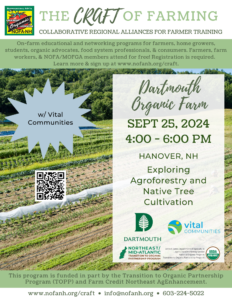 Additionally, we hosted a three day workshop for our third cohort of 10 underserved farmers across New England and New York: Agroforestry Short Course Flyer , Short Course Schedule. For each of these farmers, we did preliminary site visits prior to the three day workshop. Farmers stayed at lodgings together to maximize time together and to continue bonding together.
Additionally, we hosted a three day workshop for our third cohort of 10 underserved farmers across New England and New York: Agroforestry Short Course Flyer , Short Course Schedule. For each of these farmers, we did preliminary site visits prior to the three day workshop. Farmers stayed at lodgings together to maximize time together and to continue bonding together.
For this cohort, we did site visits prior to the educational programming. With these visits, we got to know participating farmers better and provided them with a number of materials that they could capitalize upon (e.g., aerial photography, funding opportunities, brief blurbs), and we gave them printer materials (e.g., tree inventory, zines, funding pamphlets), in addition to an online website with an online curriculum they were asked to complete prior to coming for the weekend. The program was a roaring success, with a great number of auditors and amazing engagement and satisfaction by participating farmers.
Milestones
To give a brief overview of the work we have been doing, we are excited to share a video Benedict Digiovanni created to summarize our work (hyperlinked). Additionally, we have another video update for the most recent cohort (Cohort 3, 2025).
- Engagement: Convene agroforestry transition team: Key to this project's success are strategic regional partners that will bring together agents of change in agroforestry transitions. We will convene our first meeting of our project team and advisory committee in month one. Key members will meet monthly to review programmatic success, and advisory committee members will join as they see fit, and attend annual meetings. Partners engaged: 15. Anticipated Completion Date: June, 2022, followed by monthly meetings. Status: Complete
- Engagement: Develop Curriculum for Farmer Training Program: In the first six months of our project, we will develop curriculum for our farmer training program. We will engage fifty stakeholders, including NRCS agents, farmers, foresters, agroforestry specialists, hydrologists, wildlife biologists, to provide feedback on each workshop's curriculum, connecting more potential actors of change to our project. Curriculum will be publicly available via our website post project development. Partners engaged: 25 .Estimated Completion Date: First round of outreach: August, 2022, curriculum available by August 2023. Status: Complete Accomplishments: We have successfully engaged over 90 partners in the goal of our programming through one on one meetings, email exchanges, and attending various working groups and meetings. We anticipate that this number will grow through the subsequent years of our grant. This has been one of the most exciting parts of year one as we have been able to connect farmers with others who can help them manifest their projects locally. This datasheet (Updated 2024) holds different connections made in the project. Although we have found that our curriculum needs to be reflexive from cohort to cohort, we have an extensive number of resources that we are excited to curate completely at our program's completion. We are working on a draft Wordpress site to make each session's activities, videos, and prompts accessible following the completion of our third cohort.
- Engagement: Conduct structured Stakeholder Interviews: We will interview 30 farmers in the Northeast to inform our educational programming and infrastructure with more diverse and inclusive options for agroforestry implementation tailored to a local context. Through site visits and semi-structured interviews, we will educate farmers about the function and composition of trees on their property, engage farmers in our programming, and tap into farmer networks for recruitment. Partners engaged: 30. Estimated Completion Date: October, 2023. Update: Complete. Accomplishments: We conducted 15 interviews in year one, which helped us understand the current needs of farmers in the area and helped inform the nature and scheduling of our programing. In year two, we finished the second fifteen. We are excited to analyze this data and continue to use it to inform our educational practices.
Some favorite photos from two seasons of field work!
- Engagement: Establish Nursery and Agroforestry Sites: We will establish a nursery as a source of trees for agroforestry establishment in order to subsidize the cost of initial seed trees. We will establish trees from seeds or by cuttings sourced from climatically suitable species. We will develop our own agroforestry site at the Dartmouth Organic Farm with fourteen woody species in a fractal to showcase diversity and maximize education and research opportunities. Partners engaged: 25 farmers will formally visit. Estimated Completion Date: August, 2022 Update: Completed. Accomplishments: Both the nursery and the experimental agroforestry sites are in full swing. We have used these sites to engage farmers in different ideas as well as various external community members.
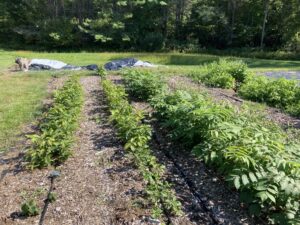
Photo of nursery (Year 1) in development 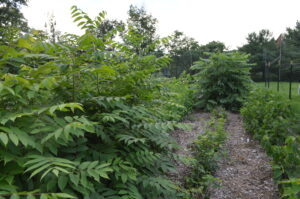
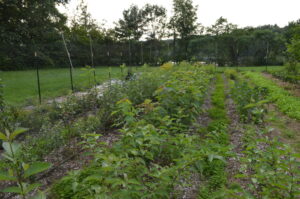
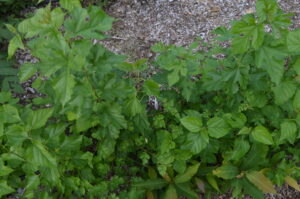
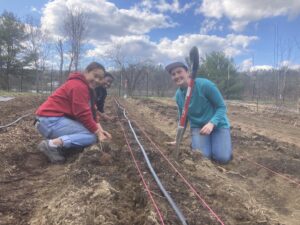
Nursery in Year 2.
Nursery in Year 3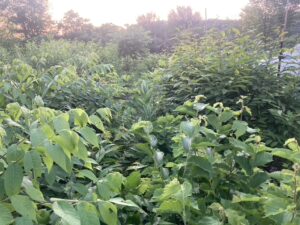
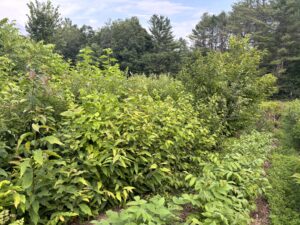
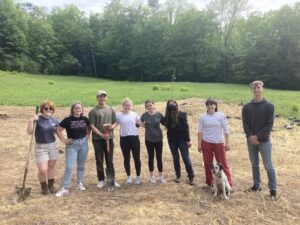
Students working to establish experimental agroforestry plot Experimental Agroforestry Plot, Year 2.
FoodForestPlotExplanation2 (1) - Engagement: Design and launch webpage: We will devote significant time to developing a website with the DALI lab. Our platform will illustrate metrics of success, portfolios of farmers, a map of available experts and pilot farms within our program, events, and shared videos and written resources. We will track engagement via pages viewed, materials downloaded, and inquiries received. Farmers engaged: at least 1000 farmers will interact with platform. Estimated Completion Date: Launch in September, 2022, continuously update with progress in 2023, 2024 and 2025. Update: In progress. Accomplishments: You can find our website here! We are still fine tuning it! https://journeys.dartmouth.edu/agroforestrytransitionhub/
- Learning: Conduct Farmer Training Program, Twenty-five farmers (5 cohorts of 5 farmers) will engage in a 10-week program on the science and practice of agroforestry. Farmers will create portfolios on their progress establishing agroforestry systems, receive individual site visits, and participate in field workshops taught by key members and guest speakers. Throughout sessions, farmers will network and share ideas for advancing agroforestry projects. Partners engaged: 25 farmers. Estimated Completion Date: Launch in November 2022, hold trainings in 2023, 2024, and 2025. Update: Complete Accomplishments: We have engaged 33 farmers fully in the curriculum that we have developed with partners around agroforestry. We ended up doing three cohorts instead of five, but engaged an equal number of farmers. This decision was made to more deeply engage with farmers Our first cohort consisted of 6 farmers who participated in a 8 week hybrid (in person/online) farmer training with eleven fantastic local guest speakers. We successfully focused on serving BIPOC farmers with four of our participating farmers identifying as BIPOC. We decided to make our programming available to others who are not actively farming, could not participate in all workshops, or who were not prioritized in our application but wanted to participate in Fall 2022. These "auditors" were a great addition to the class and allowed for dynamic conversations and for farmers to extend their networks further with other service providers and those who showed interest and motivation to be involved. (Cohort 1: Example site * Trees on Farm Project). Our second cohort consists of ten dairy farmers. We have conducted three field days and over twenty site visits with the farmers in this cohort. Similar to our first cohort, we have made our field days open for attendees not formally enrolled in the cohort. Our program has grown in popularity and we had over 50 participants in our first field day, 35 for our (very rainy) second cohort day, and 25 for our third field day. To foster more relationship building, site visits have been useful ways to connect more thoroughly with the farmers and we have brought other experts out with us to help them address agroforestry (and beyond) related questions on their sites. (Cohort 2: Example site) For our last cohort we had 14 farmers participate and over 100 applicants. We prioritized underserved farmers, particularly BIPOC farmers and redesigned our curriculum so that we could engage these farmers collectively remotely and in an intensive over the course of four days.
Cohort 1:
- Learning/Evaluation: Monitoring socio-ecological outcomes: We will work with 25 farmers to develop a monitoring plan that tracks the desired benefits of their agroforestry system. We will empower farmers with tools to track ecological, economic, and social outcomes throughout the course of their establishment and answer process-level questions on agroforestry to alleviate risk for other interested practitioners. Farmers will provide updates annually on our online platform. Partners engaged: 25 farmers. Estimated Completion Date: Monitoring will begin in 2023 and continue annually until November 2025. Update: Complete. Accomplishments: With each farmer that we worked with, primarily at site visits, we helped them develop a research idea and develop a way to establish track progress. Research questions included the composition of birds visiting agroforestry plots, changes in weed composition with trees, and amount of understory establishment.
- Learning: Foster peer to peer learning, co-develop agroforestry lighthouses: We will empower all the farmers that undergo the Farmer Training Program to consider themselves as leaders in the field of agroforestry. We will require farmers to host at least one workshop on their farm to share components of their project with their farming community. We will help them advertise and recruit at least 10 participants. Partners engaged: 275 farmers. Classes will begin in 2023 and continue annually with until November 2025. Update: Complete. Accomplishments:
In our first cohort of farmers, we helped participants develop an outreach plan or integrate their agroforestry projects into their existing or future outreach and education initiatives. Three farmers from this cohort successfully incorporated their agroforestry projects into public outreach events. One farmer hosted a "Black Walnut Salon," another organized several gatherings in the multistory food forest they created, and another hosted an art event centered around trees. These events have been wonderful opportunities for farmers to share their ideas with peers and community members, with farmers self-reporting that over sixty people have participated in these projects through these coordinated efforts.
For our second cohort, we observed a range of engagement preferences. While dairy farmers were initially more challenging to engage in the lighthouse model, we were able to hold gatherings with six farmers at their respective farms. Other farmers, though less inclined to host public-facing events, preferred to engage with their peers in a more informal, covert manner. Despite these differences, they remain enthusiastic about sharing their experiences and ideas within their peer-to-peer networks.
We are also thrilled that the third cohort is eager to integrate their agroforestry projects into diverse outreach materials, further amplifying their impact. Additionally, we’ve connected members of the second cohort to participants from the first, fostering cross-cohort relationships. Looking ahead, we aim to organize a field tour showcasing the agroforestry projects from both cohorts in Fall 2025. Finally, we are excited about the app we’re developing with the DALI lab, which will enable farmers to share information and resources virtually, broadening the reach and accessibility of their agroforestry efforts.
- Evaluation: Solicit and Analyze Feedback: Farmer members will receive invitations to provide feedback to project organizers, through an annual Qualtrix or written survey assessing effectiveness of our activities and continued support. Participants in the Farmer Training Program will also Participants in the Farmer Training Program will also receive surveys following their participation. Farmers can reflect on their experience and participate in the development of the program, which we will analyze to evaluate best practices. Partners engaged: 25 farmers. Estimated Completion Date: Farmers will be invited to participate after their initial farmer training and in each year of their continued involvement. Launches in 2023 and occurs annually until November 2025. Update: Complete. Accomplishments
Across all three cohorts of our agroforestry program, we have gathered extensive feedback from participating farmers and auditors. Pre- and post-course surveys, along with session-specific feedback, have proven invaluable in gauging changes in knowledge, perceptions, and enthusiasm for agroforestry practices. Overall, participants from all cohorts have shown significant growth in their understanding of agroforestry concepts and their ability to envision practical applications on their farms.
From our first cohort, participants reported substantial gains in knowledge and a deepened appreciation for agroforestry. One participant, who initially shared that they had “heard of agroforestry but [were] not familiar with many of the practices,” reflected post-course that they were inspired to “plant a diverse fruit and nut forest to benefit not just people now but thinking ahead several generations,” and expressed a desire to explore “more on tree compatibility.” Another participant with some background in agroforestry remarked that the course had given them “good information about available resources,” raised new questions about the potential of agroforestry systems, and fostered meaningful connections with others in the field. Quantitatively, participants in this cohort rated their understanding of agroforestry concepts as 1.4/5 before the course, which rose to 4.2/5 afterward—a clear indicator of success.
Our second cohort, which self-identified as having less experience with agroforestry at the outset, also demonstrated remarkable progress. Participants noted the program helped them envision actionable projects on their farms. One farmer, motivated by the course, attended their local Conservation District meeting to advocate for more resources to support silvopasture establishment. Another farmer shared that the course had given them the confidence to plan a small-scale agroforestry project incorporating riparian buffers and native species. Feedback from this cohort reinforced the importance of providing resources tailored to beginner-level practitioners while encouraging them to expand their knowledge and take the first steps toward implementation.
The third cohort brought their own unique perspective and energy to the program, integrating their agroforestry learnings into diverse outreach projects and advocacy efforts. One farmer from this cohort hosted a field day on their farm to showcase their agroforestry project to peers and community members, noting that the experience "allowed me to share what I’ve learned and inspire others to think about trees differently.” Another participant described how they were incorporating agroforestry concepts into their existing educational materials, saying, "This course has given me the tools and confidence to add agroforestry to our community workshops, making the topic more accessible." Farmers from this cohort expressed excitement about applying what they learned to long-term farm planning and contributing to outreach materials that will continue to promote agroforestry far beyond the program.
Quantitatively, all three cohorts saw significant improvements in their ratings of agroforestry knowledge. See this figure for more on that: Agroforestry practices. These results reflect the collective growth of participants and the program’s success in equipping them with the skills, confidence, and resources to integrate agroforestry into their farming systems.
- Evaluation/Learning/Engagement: Share Outcomes in Conferences: Farmers will hear presentations from project PI and key members at regional conferences such as the Northeast Organic Farming Association (NOFA) Conference, Just Food, and the Association for Temperate Agroforestry (AFTA). These conferences will be a recruitment opportunity for the program, and expose more potential practitioners to the benefits of agroforestry. Proposed number of farmer beneficiaries who will participate: 250. Estimated completion date: November 20, 2025. In progress. Accomplishments: In summer 2022, we attended the World Agroforestry Conference, where we were able to share out ideas for the project and engage with other practitioners, particularly those nearby, who were excited to partner with us. We have also actively engaged in the VT Farm to Plate Agroforestry Working Group. We also presented at the Temperate Agroforestry Conference in February 2024 and the Integrative Conservation Conference in February 2024. Several other professionals we met at the conference ended up being guest speakers or resources available to local farmers. We have presented at a wide variety of different community meetings and will be presenting at the upcoming NOFA VT Conference..
Milestone Activities and Participation Summary
Educational activities:
Participation Summary:
Learning Outcomes
Performance Target Outcomes
Target #1
25
Incorporate woody species into farm
25 acres
soil water infiltration improvement
25
Incorporate woody species into farm
35 acres
Although it was a very wet year, farmers who had began planting discussed high survivorship rates of trees. We will do all of our infiltration monitoring this summer.
Overall:
We have successfully completed programming with all 25 participating farmers and engaged over 100 additional auditors through our various programs. The diversity, complexity, and depth of the projects farmers are undertaking have been remarkable. Each farm brings unique challenges and goals, underscoring the need for tailored agroforestry practices rather than prescriptive solutions. This initiative has highlighted the resilience and innovation of farmers across the region.
Cohort 1:
The first cohort included six farmers who collectively planted over 300 trees as part of their agroforestry systems. While some trees were distributed directly to farmers, most were planted collaboratively with the farmers and our team. In addition to the participating farmers, the program attracted 30 auditors, including farmers, technical service providers, and educators, as tracked via event sign-up sheets. Participating farmers have shared their experiences with peers and community members, further amplifying the impact of the program.
Cohort 2:
The second cohort featured ten dairy farmers and included field days that attracted nearly 100 attendees, as recorded on sign-up sheets, along with over 35 site visits. We completed planting projects with all participating farmers, tailoring educational materials to each farm's specific needs. These materials included planting and monitoring plans. Additionally, we measured soil infiltration and conducted soil tests at each site to guide successful project implementation.
Cohort 3:
In the third cohort, we worked with ten farmers from across New England and New York. After conducting site visits and providing mentorship, we helped each farmer develop customized plans and supplied them with trees to implement their agroforestry projects independently. although we have been helping with implementation and more planning. This cohort demonstrated the regional interest in innovative and site-specific agroforestry practices.
Reflection:
This project has been a powerful illustration of farmer ingenuity and adaptability. Each participating farmer has approached agroforestry with a unique vision, addressing the specific challenges of their farm and landscape. The collective success of these programs has further emphasized the importance of fostering resilient and individualized agroforestry solutions in our region.
Additional Project Outcomes
As highlighted earlier, we successfully invited auditors to participate in the program, engaging over 150 additional individuals across both cohorts. This approach significantly broadened the reach of our programming, fostering connections between participating farmers and a diverse group of non-farmers interested in agroforestry in the region. The inclusion of auditors enriched the program by introducing fresh perspectives and expanding networking opportunities within the agroforestry community.
During the second cohort, the increased number of site visits provided a valuable opportunity to deepen collaborations. By inviting more experts to engage directly with farmers, we facilitated the development of actionable plans and explored innovative funding sources. This hands-on approach strengthened the ties between practitioners and experts, enhancing the program’s impact.
Additionally, we collaborated with the White River Conservation District on a grant initiative to provide educational programming for an upcoming grazing-focused cohort through the Northeast Dairy Business Innovation Center. While we did not receive direct funding from this effort, our contributions to the grant materials helped secure $150,000 for the project. This fruitful partnership has significantly advanced our regional planning efforts and highlighted the value of cross-organizational collaboration.
We also supported fifteen farmers, spanning both cohorts, in applying for further funding via American Farmland Trust, NRCS, Working Lands Grants, SARE Farmer Grants, NOFA grants, and more. These efforts continue to expand agroforestry adoption across the region while providing critical financial support to participating farmers,.
Although we felt inspired by all of our farmers, we particularly wanted to showcase a farmer who contributed greatly to our own understanding of future food systems in the region while making the most out of resources made available throughout the cohort. This participant is a BIPoC farmer who owns a diversified production (vegetables, chickens, and value added products) in Northern Vermont. Her farm has served as a food and educational site, as well as a performance space for BIPoC artists. When she first joined the Agroforestry Hub, she had a slight knowledge of agroforestry practices– though she understood some environmental benefits, she had limited knowledge of system design. As an initial idea for implementing agroforestry on her farm, she stated, “We have a hillside that was logged out… and we have been considering how to replant it, creating a food forest, orchard, or managing water & run off.” After a course on species selection, she used her learnings to expand her thinking, stating in a second workshop reflection: “I'd like to create a windbreak stand of edible species along the stream. Plums, Cherry Plums, Asian Pears, Crabapple, Roses for Rose hips, pie Cherries, Pawpaws and Hazelnuts all appeal to me… I'm thinking about how to do edible food hedgerows on all our boundaries, along the waterways, & around the ponds.” This participant also gained inspiration from her peers and guest speakers. After our field day to Perfect Circle Farm, managed by Buzz Ferver, she described that she became interested in “Putting in seedling starting beds in one field for growing out trees, shrubs and rare crops from seed like [expert from programming] does - Very inspiring site indeed!” It is notable to mention that at that site, they shared out a story of the importance of some seed that an expert we brought in from programming has from Salem Oak tree, and the significance of this particular tree marginalized communities. This resulted in a discussion about the many values of trees on farms, particularly the often neglected by mainstream agroforestry campaigns, cultural values.
The growth this participant experienced when it came to funding opportunities was also astounding. She detailed how she often had trouble applying for farm project funding, stating that she “never thought to apply for any of these funds or technical assistance due to fear, and to not understanding the specific jargon and lingo that is used.” She particularly mentioned legacies of land being stolen from their families, and intergenerational warnings of working with government entities. Yet, after taking the funding applications portion of our Agroforestry workshop, she felt empowered to reach out and seek help from our NRCS guest speakers in applying, putting in an application for several grants. This participant, along with many other BIPoC participants, stated the importance of having BIPoC technical service providers throughout the program. In reference to her grant applications, Ama now states, “I hope to be approved and offered a good contract that I can fulfill!”
As the workshop has come to an end, we have been inspired by her wish to connect others with agroforestry. We planted over fifty high value trees across her farm in various challenging areas. As she has stated in an exit survey, “It's invaluable to me for us to meet and connect with other farmers of color across the state of VT… May I serve as a mentor and educational spot for young farmers and agroforesters of Color? I'm very dedicated to working with BIPoC in VT and the other NE states… Could we host design workshops here in collaboration? Cowrite grants with you and SARE?” Since, this participant has shared out her project with many farmers as well as community members through her popular salon style gatherings where she gathers a nexus of "foodies, farmers, and novices". She successfully has been funded by NRCS for a hoophouse on her site and we are working to apply to new funding sources to expand her agricultural and educational activities on her farm.
2023: We had challenges keeping our goals of BIPOC focus with the desire for in-person community building. As a result, we extended our programming to include more zoom/hybrid sessions which were challenging to execute. We also found that we may need to limit the time of our speakers to allow for effective discussion periods and want to shorten the programming to accommodate farmer's schedules.
2024: Our second cohort was successful in its flexibility to meet the needs of the specific farming community that we worked with--dairy farms. To ensure attendance and participation, these farmers needed more flexible scheduling, more site visits. We are looking forward to catering our programming to the specific needs of our next cohort to optimize participation and learning.
2025: We are thrilled with how each cohort has been uniquely tailored to meet the specific needs of the farming communities we’ve partnered with. This year, we’re especially excited to develop and analyze the rich data collected over the course of the program, drawing insights to further enhance our efforts. As the grant period comes to a close, we are committed to staying connected with the farmers, supporting them as they pursue new grant opportunities and work toward realizing their visions and dreams. It’s been an incredible journey, and we look forward to continuing this meaningful work.
